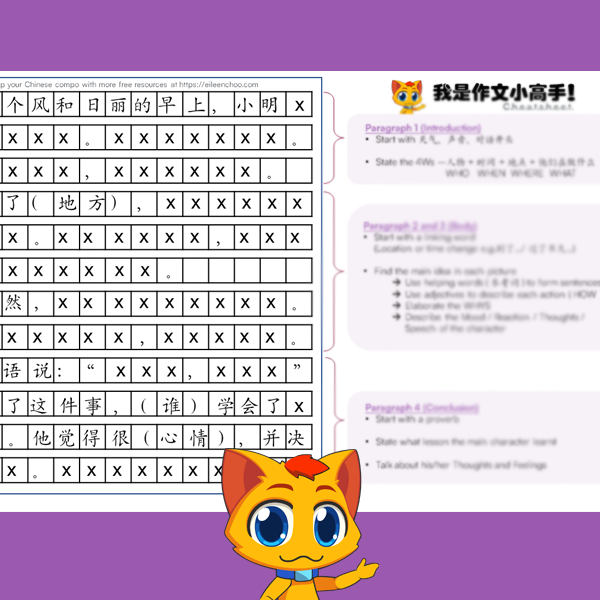
Lost at the start of your Chinese composition writing?
If you always stuck at your compo starting or find yourself staring at a blank sheet of paper when you need to write a Chinese composition, this guide will help you learn how to start writing your introduction easily.
Why compo writing is so hard
I’m sure we’ve all thought of these questions when we were students ourselves:
- How should I start my compo?
- What kind of compo starting is the best?
- What should I write about?
- Is there a Chinese composition introduction that I can use for every compo?
Yes, beginning a Chinese compo is always the hardest part of writing. It takes the longest time to think about but once you have the start, the rest is going to be much easier.
Luckily, after teaching Chinese composition writing to so many primary school children, I’ve found a useful introduction writing formula that can work for any Chinese compo!
So pay attention if you are just starting to learn about composition writing in Primary 2 or 3. This will be a life saver.
The fool-proof way of starting your Chinese composition
The formula that we are going to use is the 4W formula – the who-what-where-when formula.
If you prefer to watch a video instead, check out this video above where we’ll cover:
- What makes a good Chinese composition starting
- Chinese compo starting phrases that you can use
- Example of Chinese composition weather starting
- Example of how to write a complete Chinese compo’s beginning
Otherwise, here’s a breakdown of the each component:
Starting your Chinese composition introduction with the 4Ws
Who
There is always a main character in any story. Identify that character and tell the readers who he or she is at the start so that they know whose story they are reading.
What
Your main character is always busy with something in the first picture. Describe “what” they are doing in the picture so that the readers will know what to expect.
Where
This is simple. “Where” is the location that the story takes place. Is it at home? Is it in school? Telling your readers where the main character is at will help your readers create a scene in their minds for your story to happen.
When
Finally, think about when the story takes place. If your readers know the time of the day that your story is happening, they’ll have a clearer timeline of the events that follow.
Once you have these 4 elements in your intro, top it off with some good weather phrases and your chinese composition is good to go!
Start writing your Chinese composition confidently
Now that you’ve learn the formula to start a Chinese composition, it’s time to put it to practise.
Try writing your next composition introduction based on what I’ve shared and see if you can apply it. Once you’re used to it, starting a Chinese compo is going to be easy.
Besides describing the weather to start your Chinese composition, there are also other good ways to start such as introducing the main character’s personality traits or using flashbacks.
However, I’ve found that opening a compo with the main character’s personality traits or using flashbacks requires a higher level of thinking and may backfire if used wrongly. So unless you are taking higher Chinese, I would advise against using such openings.
Let me know in the comments below if you have any other questions about composition writing in Chinese! Otherwise, you might want to learn how to write a perfect ending for your compo next.
看图写话开头小高手
看图写话的开头到底要怎么写呢?作文开头要有些什么?小一小二的学生在学会写看图作文前,都要学会看图写话的基本功。说到写作,很多学生都会在开头的时候卡住,不知道究竟要写些什么。
如果你也面对以上的问题,别担心!今天朱老师就教一二年级的同学怎么写出一段好的作文开头,让大家看看要怎么加入人物、时间、天气等等。只要你学会了这个写作技巧,懂得怎么把开头写好,以后写看图作文的时候就不会这么头痛了哦!






